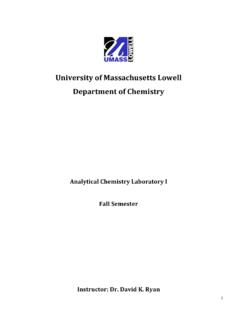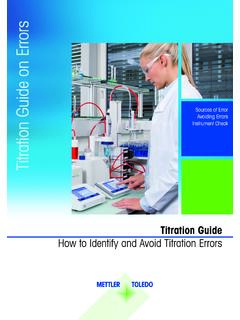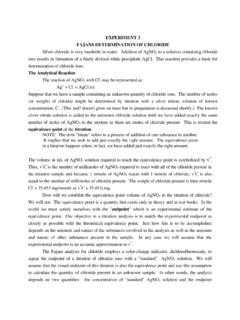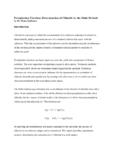Transcription of Chapter 9
1 391 Chapter 9 Titrimetric MethodsChapter Overview9A Overview of Titrimetry9B Acid Base Titrations9C Complexation Titrations9D Redox Titrations9E precipitation Titrations9F Key Terms9G Chapter Summary9H Problems9I Solutions to Practice ExercisesTitrimetry, in which volume serves as the analytical signal, first appears as an analytical method in the early eighteenth century. Titrimetric methods were not well received by the analytical chemists of that era because they could not duplicate the accuracy and precision of a gravimetric analysis . Not surprisingly, few standard texts from that era include titrimetric methods of analysis . precipitation gravimetry first developed as an analytical method without a general theory of precipitation .
2 An empirical relationship between a precipitate s mass and the mass of analyte in a sample what analytical chemists call a gravimetric factor was determined experimentally by taking a known mass of analyte through the procedure. Today, we recognize this as an early example of an external standardization. Gravimetric factors were not calculated using the stoichiometry of a precipitation reaction because chemical formulas and atomic weights were not yet available! Unlike gravimetry, the development and acceptance of titrimetry required a deeper understanding of stoichiometry, of thermodynamics, and of chemical equilibria. By the 1900s, the accuracy and precision of titrimetric methods were comparable to that of gravimetric methods, establishing titrimetry as an accepted analytical Chemistry Overview of TitrimetryIn titrimetry we add a reagent, called the titrant, to a solution that contains another reagent, called the titrand, and allow them to react.
3 The type of reaction provides us with a simple way to divide titrimetry into four categories: acid base titrations, in which an acidic or basic titrant reacts with a titrand that is a base or an acid; complexometric titrations , which are based on metal ligand complexation; redox titrations, in which the titrant is an oxidizing or reducing agent; and precipitation titrations, in which the titrand and titrant form a precipitate. Despite their difference in chemistry, all titrations share several com-mon features. Before we consider individual titrimetric methods in greater detail, let s take a moment to consider some of these similarities. As you work through this Chapter , this overview will help you focus on the similari-ties between different titrimetric methods.
4 You will find it easier to under-stand a new analytical method when you can see its relationship to other similar Equivalence Points and End pointsIf a titration is to give an accurate result we must combine the titrand and the titrant in stoichiometrically equivalent amounts. We call this stoichio-metric mixture the equivalence point. Unlike precipitation gravimetry, where we add the precipitant in excess, an accurate titration requires that we know the exact volume of titrant at the equivalence point, Veq. The product of the titrant s equivalence point volume and its molarity, MT, is equal to the moles of titrant that react with the #=If we know the stoichiometry of the titration reaction, then we can calculate the moles of , for most titration reactions there is no obvious sign when we reach the equivalence point.
5 Instead, we stop adding the titrant at an end point of our choosing. Often this end point is a change in the color of a substance, called an indicator, that we add to the titrand s solu-tion. The difference between the end point s volume and the equivalence point s volume is a determinate titration error. If the end point and the equivalence point volumes coincide closely, then this error is insignificant and is safely ignored. Clearly, selecting an appropriate end point is of criti-cal Volume as a SignalAlmost any chemical reaction can serve as a titrimetric method provided that it meets the following four conditions. The first condition is that we must know the stoichiometry between the titrant and the titrand.
6 If this is not the case, then we cannot convert the moles of titrant used to reach We will deliberately avoid the term ana-lyte at this point in our introduction to titrimetry. Although in most titrations the analyte is the titrand, there are circum-stances where the analyte is the titrant. Later, when we discuss specific titrimet-ric methods, we will use the term analyte where of measuring the titrant s volume, we may choose to measure its mass. Al-though generally we can measure mass more precisely than we can measure vol-ume, the simplicity of a volumetric titra-tion makes it the more popular choice. 393 Chapter 9 Titrimetric Methodsthe end point to the moles of titrand in our sample.
7 Second, the titration reaction effectively must proceed to completion; that is, the stoichiometric mixing of the titrant and the titrand must result in their complete reaction. Third, the titration reaction must occur rapidly. If we add the titrant faster than it can react with the titrand, then the end point and the equivalence point will differ significantly. Finally, we must have a suitable method for accurately determining the end point. These are significant limitations and, for this reason, there are several common titration simple example of a titration is an analysis for Ag+ using thiocyanate, SCN , as a titrant.()()()aqaqsAgSCNAg(SCN)?++-This reaction occurs quickly and with a known stoichiometry, which satis-fies two of our requirements.
8 To indicate the titration s end point, we add a small amount of Fe3+ to the analyte s solution before we begin the titration. When the reaction between Ag+ and SCN is complete, formation of the red-colored Fe(SCN)2+ complex signals the end point. This is an example of a direct titration since the titrant reacts directly with the the titration s reaction is too slow, if a suitable indicator is not avail-able, or if there is no useful direct titration reaction, then an indirect analy-sis may be possible. Suppose you wish to determine the concentration of formaldehyde, H2CO, in an aqueous solution. The oxidation of H2CO by I3-()()()()()()aqaqaqaqaqlHCOI3 OHHCO3I2HO2322?++++----is a useful reaction, but it is too slow for a titration.
9 If we add a known excess of I3- and allow its reaction with H2CO to go to completion, we can titrate the unreacted I3- with thiosulfate, SO232-.()()()()aqaqaqaqI2 SOSO3I3232462?++----The difference between the initial amount of I3- and the amount in excess gives us the amount of I3- that reacts with the formaldehyde. This is an example of a back ions play an important role in many environmental systems. A direct analysis for Ca2+ might take advantage of its reaction with the ligand ethylenediaminetetraacetic acid (EDTA), which we represent here as Y4 .()()()aqaqaqCaYCaY242?++--Unfortunately , for most samples this titration does not have a useful indica-tor. Instead, we react the Ca2+ with an excess of MgY2 ()()()()aqaqaqaqCaMgYCaYMg2222?
10 +++--+releasing an amount of Mg2+ equivalent to the amount of Ca2+ in the sample. Because the titration of Mg2+ with EDTA()()()aqaqaqMgYMgY242?++--Depending on how we are detecting the endpoint, we may stop the titration too early or too late. If the end point is a func-tion of the titrant s concentration, then adding the titrant too quickly leads to an early end point. On the other hand, if the end point is a function of the titrant s con-centration, then the end point exceeds the equivalence is an example of a precipitation ti-tration. You will find more information about precipitation titrations in Section is an example of a redox titration. You will find more information about redox ti-trations in Section is the Mg2+ EDTA metal li-gand complex.








